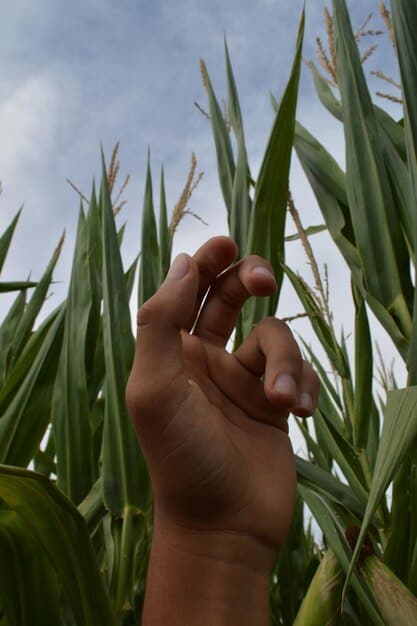2025 Farm Bill: Food Prices, Subsidies, & US Economy

The 2025 Farm Bill is anticipated to significantly influence US food prices and agricultural subsidies by recalibrating commodity programs, conservation efforts, and nutrition assistance, potentially affecting both farmer income and consumer grocery bills.
As discussions around the next comprehensive USDA Farm Bill intensify, a crucial question emerges: How will the 2025 Farm Bill impact food prices and agricultural subsidies in the US? This legislation, renewed approximately every five years, dictates the direction of American agriculture and, by extension, the plates of millions. Its provisions will shape everything from the cost of your morning cereal to the financial stability of farming communities across the nation, making an understanding of its potential effects paramount for consumers, producers, and policymakers alike.
understanding the farm bill’s essence and evolution
The Farm Bill is not a singular piece of legislation but a comprehensive, omnibus bill covering a wide array of programs affecting the American food and farm system. Enacted roughly every five years, it addresses subjects from crop insurance and commodity support to conservation and nutrition initiatives. Its roots trace back to the Great Depression, when the Agricultural Adjustment Act of 1933 aimed to stabilize agricultural markets and ensure a reliable food supply. Over the decades, its scope has broadened considerably, reflecting evolving societal needs and economic landscapes.
The evolution of the Farm Bill underscores a dynamic interplay between agricultural production, environmental stewardship, and social welfare. Each iteration seeks to balance the interests of diverse stakeholders—farmers, agribusinesses, consumers, and environmental groups—while adapting to new challenges such as climate change, global trade dynamics, and public health concerns. The 2025 Farm Bill is expected to continue this trend, with significant debates looming over its funding allocations and programmatic priorities. This legislative undertaking is complex, requiring extensive negotiation and compromise among members of Congress, agricultural committees, and advocacy groups.
historical context of farm bills
Historically, Farm Bills have served as a critical mechanism for the federal government to intervene in agricultural markets. Early versions focused predominantly on commodity programs, designed to support farm income and stabilize prices through direct payments, loan programs, and supply management. These mechanisms were crucial in protecting farmers from volatile market swings and natural disasters.
- Commodity Programs: Provide financial support for staple crops like corn, soybeans, wheat, rice, and cotton, often influencing what farmers choose to plant.
- Conservation Programs: Incentivize sustainable farming practices, aiming to protect natural resources and mitigate environmental impacts.
- Nutrition Programs: Primarily SNAP (Supplemental Nutrition Assistance Program), which supports food access for low-income households, representing a significant portion of the bill’s budget.
- Crop Insurance: Helps farmers manage risk from adverse weather and market fluctuations, serving as a critical safety net.
shift towards diversification
In recent decades, the Farm Bill has diversified its focus beyond traditional commodity support. Conservation programs, once a minor component, have grown in importance, reflecting a greater emphasis on environmental protection and climate resilience. The inclusion of nutrition programs, particularly SNAP, has also dramatically expanded the bill’s reach, transforming it into a piece of legislation with profound implications for both rural and urban communities. This expanded scope often leads to spirited debates, as advocates for different priorities vie for limited federal resources. The bipartisan nature of its passage is often tenuous, requiring broad coalition-building.
Looking ahead to 2025, policymakers face the challenge of crafting a bill that addresses contemporary issues while upholding the foundational goals of farm support and food security. The balance between protecting farmers, ensuring affordable food for consumers, and promoting environmental sustainability will be at the forefront of legislative discussions. Navigating these competing interests successfully will be crucial for the bill’s overall effectiveness and long-term impact on the American agricultural landscape. The final contours of the bill will be largely shaped by economic conditions, political pressures, and prevailing agricultural trends.
projected impact on food prices: navigating complexity
The intricate mechanisms of the Farm Bill exert a substantial, albeit often indirect, influence on food prices in the United States. While direct price controls are rare, the legislation’s programmatic design—particularly through commodity programs, crop insurance, and conservation incentives—shapes the supply and cost of agricultural products. Understanding this influence requires a nuanced look at how various provisions can ripple through the food supply chain, ultimately affecting what consumers pay at the grocery store.
Changes in subsidy structures can alter farmers’ planting decisions, thereby impacting the availability and variety of certain crops. For instance, if the bill significantly increases support for one commodity, farmers might shift production towards that crop, potentially affecting the supply and price of others that become less attractive to cultivate. Similarly, modifications to crop insurance provisions can affect farmers’ risk tolerance and their ability to withstand adverse weather events, which in turn can influence yields and market prices.

commodity programs and their price ripple effect
Commodity programs, such as Price Loss Coverage (PLC) and Agricultural Risk Coverage (ARC), establish financial safety nets for farmers when market prices fall below a certain threshold or revenues decline. While these programs are designed to stabilize farmer income, they implicitly influence supply decisions. If the support prices are set too high, they might encourage overproduction of certain commodities, leading to an abundance that could depress market prices. Conversely, if support is reduced, farmers might scale back production, potentially driving up prices due to scarcity.
- Direct Payments: Can reduce farmer risk, promoting consistent supply.
- Loan Programs: Allow farmers to store crops until prices improve, influencing market availability.
- Counter-Cyclical Payments: Kick in during periods of low prices, potentially preventing widespread farm failures that could disrupt supply.
- Conservation Reserve Program (CRP): Taking land out of production for conservation can reduce overall supply, thus impacting prices.
conservation and nutrition impacts
Beyond traditional commodity support, conservation programs and nutrition assistance also have a subtler, yet significant, bearing on food prices. Programs like the Conservation Stewardship Program (CSP) and Environmental Quality Incentives Program (EQIP) incentivize farmers to adopt sustainable practices, which can sometimes reduce yields in the short term, but enhance soil health and resilience in the long run. These practices may have indirect cost implications that could be passed on to consumers.
On the nutrition front, large programs like SNAP do not directly affect food production costs but significantly impact demand. By providing purchasing power to millions of low-income Americans, SNAP increases overall demand for food, particularly for staple goods. While this generally supports the agricultural sector, a substantial change in SNAP funding could alter demand patterns, potentially influencing prices for certain food categories, especially fresh produce and pantry staples. The aggregate effect of these diverse programs coalesces to determine the ultimate grocery bill for American consumers, making the 2025 Farm Bill a critical, price-sensitive piece of legislation.
agricultural subsidies: reforms and repercussions
Agricultural subsidies are a cornerstone of US farm policy, providing financial support to producers through various mechanisms. These subsidies aim to stabilize farm income, promote specific agricultural practices, and ensure a reliable food supply. However, their impact is complex, extending beyond farm gates to influence market dynamics, environmental outcomes, and international trade relations. The 2025 Farm Bill is poised to critically examine and potentially reform these subsidy structures, which could have far-reaching repercussions for both farmers and the broader economy.
The debates surrounding agricultural subsidies often involve contentious discussions about their fairness, efficiency, and environmental footprint. Critics argue that some subsidies disproportionately benefit large agricultural operations, distort markets, and incentivize environmentally harmful practices. Proponents, however, contend that subsidies are essential for maintaining a strong agricultural sector, protecting farmers from market volatility, and ensuring food security. The ongoing push for reform highlights a desire to make these programs more targeted, equitable, and sustainable, reflecting a broader shift in policy priorities towards environmental stewardship and climate resilience.
types of subsidies and their roles
US agricultural subsidies encompass a variety of programs, each designed to address specific aspects of farming and food production. Understanding these categories is essential for appreciating the multifaceted nature of federal support and the potential impacts of proposed reforms. The primary types include commodity support, conservation payments, and crop insurance premium subsidies.
- Commodity Subsidies: Offer direct payments or price supports for specific crops like corn, soybeans, and wheat, often tied to market prices or historical yields. They act as a safety net for farmers.
- Conservation Subsidies: Provide financial incentives for farmers to adopt environmentally friendly practices, such as reducing soil erosion, improving water quality, and protecting wildlife habitats.
- Crop Insurance Subsidies: The government covers a significant portion of farmers’ crop insurance premiums, reducing the financial burden of managing risk from natural disasters and market price fluctuations.
- Disaster Assistance: Programs offering financial aid to farmers affected by natural disasters, which can supplement or sometimes replace insurance payments.
potential reforms and their implications
Looking towards the 2025 Farm Bill, several key areas of subsidy reform are likely to be debated. These include adjustments to payment limits for commodity programs, a greater emphasis on climate-smart agriculture, and potential changes to how crop insurance is structured. Any significant alteration to these programs could provoke substantial reactions from agricultural stakeholders.
For example, if payment limits on commodity programs are tightened, it could disproportionately affect larger farms, potentially leading to shifts in production practices or land use. Conversely, increased funding for conservation programs could encourage more widespread adoption of sustainable farming methods, potentially enhancing environmental quality but perhaps also altering commodity markets. The debate over direct versus indirect subsidies also continues, with some advocating for a shift away from production-linked payments towards income-based support. These reforms could fundamentally reshape the economic landscape for American farmers, forcing them to adapt to new incentive structures and market realities while influencing agricultural innovation and competitiveness on a global scale.
the interplay: farm programs, consumer wallets, and global markets
The policies ensconced within the Farm Bill do not exist in isolation; they are deeply intertwined with the daily lives of American consumers and the complexities of global agricultural markets. The decisions made regarding farm programs directly influence not only the viability of domestic farming operations but also the prices consumers pay for food, the nutritional adequacy of diets, and the competitive standing of US agricultural exports on the international stage. This intricate interplay necessitates a holistic understanding of the bill’s provisions and their cascading effects across various sectors.
The connection between farm programs and consumer wallets is often indirect but profound. Subsidies can stabilize the supply of certain commodities, potentially mitigating price volatility for consumers. Conversely, if subsidies incentivize the production of specific crops disproportionately, it could lead to an abundance that lowers prices for those specific items, while potentially raising prices for goods where production has been curtailed. This delicate balance reflects the nuanced approach required in crafting effective agricultural policy that serves both producers and consumers.
domestic impacts: food access and innovation
Domestically, the Farm Bill’s impact on food prices extends beyond the farm gate to affect household budgets and food security. While some argue that subsidies contribute to lower food prices by stabilizing supply, others contend that they can distort markets and lead to less efficient production. However, it’s undeniable that programs like SNAP play a direct role in enhancing food access for millions, thereby influencing overall food demand and indirectly supporting the agricultural sector.
- Food Security: Nutrition programs like SNAP are crucial for ensuring vulnerable populations have access to an adequate diet, affecting both their health and economic stability.
- Dietary Shifts: Subsidies for certain commodity crops (e.g., corn, soy) can influence the availability and cost of processed foods, potentially impacting public health outcomes.
- Technological Adoption: Research and development funding within the Farm Bill can drive agricultural innovation, leading to more efficient farming practices and potentially lower production costs in the long run.
- Rural Economies: Farm programs provide a vital economic lifeline to rural communities, preserving jobs and local economies that ripple through the broader national economy.
global market ramifications and trade
On the global stage, US agricultural subsidies can have significant ramifications for international trade and competition. Other countries often view US subsidies as trade-distorting, arguing that they give American farmers an unfair advantage. This can lead to trade disputes and impact the global agricultural supply chain. The extent to which the 2025 Farm Bill addresses these concerns will be critical for maintaining harmonious international trade relations and ensuring American competitiveness.
Moreover, the global demand for food is continually rising, influenced by population growth and changing dietary preferences. How the Farm Bill positions US agriculture to meet this demand—through innovation, sustainability, and market access—will dictate its role as a global food provider. Balancing domestic needs with international responsibilities is a complex challenge, making the 2025 Farm Bill not just a national policy but a critical piece of the global food security puzzle.
conservation, climate, and the 2025 farm bill’s mandate
As the climate crisis intensifies, the 2025 Farm Bill faces an unprecedented mandate: to integrate robust conservation and climate-resilient agricultural practices more deeply into its core. Historically, conservation has been a component of the Farm Bill, but there’s growing pressure and opportunity to expand its scope and funding in light of extreme weather events, soil degradation, and water scarcity. This shift recognizes that the sustainability of American agriculture is inextricably linked to the health of its natural resources and its capacity to adapt to a changing climate.
The legislative debate around conservation and climate within the Farm Bill is pivotal. It involves balancing the need for increased environmental stewardship with the economic realities faced by farmers. Successful integration will require innovative policy mechanisms, sufficient funding for incentive programs, and a collaborative approach that empowers farmers to adopt practices that benefit both their land and the planet. This focus underscores a broader societal recognition of agriculture’s role as both a contributor to and a potential solution for climate challenges.

strengthening conservation programs
The 2025 Farm Bill is anticipated to prioritize strengthening and expanding existing conservation programs like the Environmental Quality Incentives Program (EQIP) and the Conservation Stewardship Program (CSP). These programs provide financial and technical assistance to farmers and ranchers who voluntarily implement conservation practices. The debate will likely revolve around increased funding, refined program rules to enhance climate benefits, and efforts to reach a broader range of producers, including those traditionally underserved.
A key focus will be on incentivizing “climate-smart” practices, which not only reduce greenhouse gas emissions but also enhance carbon sequestration in soils. Such practices include no-till farming, cover cropping, diversified crop rotations, and improved nutrient management. These practices offer multiple co-benefits, such as improved water quality, enhanced biodiversity, and increased resilience to droughts and floods. The challenge lies in designing programs that are accessible, effective, and attractive to farmers across different scales and types of operations, ensuring broad adoption and measurable environmental gains.
balancing production with environmental stewardship
The fundamental challenge within the Farm Bill is how to balance the imperative of agricultural production with the growing demand for environmental stewardship. Policymakers must devise strategies that support farmers in producing food and fiber efficiently while simultaneously encouraging them to mitigate their environmental footprint and adapt to climate change. This involves exploring new opportunities for market-based conservation, such as carbon credit markets, and providing robust technical assistance to help farmers implement complex conservation plans.
Furthermore, discussions around the 2025 Farm Bill will likely include provisions related to renewable energy development on farms, protecting critical habitats, and managing water resources more effectively in arid regions. The bill’s eventual design will reflect a collective vision for American agriculture that is productive, profitable, and environmentally responsible, ensuring its long-term viability in a changing world. The emphasis on climate adaptation and mitigation within this bill is a defining characteristic, marking a significant evolution in agricultural policy.
nutrition programs: a critical pillar of the farm bill
Beyond its agricultural focus, the Farm Bill serves as the primary legislative vehicle for federal nutrition programs, most notably the Supplemental Nutrition Assistance Program (SNAP). This duality—linking farm subsidies with food assistance—underscores the bill’s role as a comprehensive policy instrument addressing both the supply and demand sides of the American food system. The nutrition title typically accounts for the largest share of the Farm Bill’s budget, making its renewal a critical discussion point for hunger advocates, policymakers, and constituents alike.
The continued debate over SNAP funding, eligibility, and benefit levels highlights the program’s vital role in combating food insecurity and providing a safety net for millions of low-income individuals and families. The discussions surrounding the 2025 Farm Bill will undoubtedly scrutinize these aspects, with potential reforms impacting the ability of vulnerable populations to access nutritious food. The decisions made in this section of the bill will have profound social and economic consequences, extending well beyond the agricultural sector.
snap: backbone of food security
SNAP, formerly known food stamps, is the cornerstone of federal food assistance efforts. It provides eligible low-income individuals and families with financial assistance to purchase groceries, thereby increasing their access to healthy food and alleviating food insecurity. The program not only supports beneficiaries but also injects significant economic activity into local communities, benefiting grocery stores and the broader food industry. The sheer scale of SNAP makes it a pivotal element of the Farm Bill’s overall impact.
- Eligibility Criteria: Debates often center on income thresholds, work requirements, and other eligibility factors that determine who qualifies for benefits.
- Benefit Levels: Discussions frequently arise regarding the adequacy of benefit levels to meet nutritional needs, particularly in light of rising food prices.
- Program Administration: Efforts to streamline and improve the efficiency of SNAP delivery are ongoing, aiming to reduce administrative burdens and enhance access.
- Public Health Outcomes: SNAP is widely recognized for its positive impact on the health and well-being of low-income individuals, contributing to better dietary patterns and reduced health disparities.
potential reforms and their societal impact
As deliberations for the 2025 Farm Bill unfold, several potential reforms to SNAP and other nutrition programs will likely be on the table. These could include changes to work requirements, adjustments to the calculation of benefit levels, and discussions around funding for nutrition education and incentive programs that encourage the purchase of fruits and vegetables. Any significant tightening of eligibility or reduction in benefits could lead to increased food insecurity and greater strain on local food banks and charitable organizations.
Conversely, proposals to expand access or enhance benefits would bolster the program’s ability to serve vulnerable populations effectively. The outcome of these negotiations will reflect prevailing political priorities, economic conditions, and public sentiment regarding social safety nets. The nutrition title’s inclusion within the Farm Bill also highlights the fundamental connection between agricultural production and consumer well-being, emphasizing that a robust food system must feed both the land and its people, ensuring that efforts to support farmers ultimately translate into food access for all citizens.
the road ahead: challenges and opportunities for the 2025 farm bill
As the 2025 Farm Bill moves through the legislative process, it faces a complex landscape of economic, environmental, and social challenges, alongside significant opportunities for innovation and positive change. Crafting a bill that effectively addresses the diverse needs of American agriculture, consumers, and natural resources requires careful consideration, robust debate, and a willingness to adapt to evolving realities. The stakes are high, as the decisions made will shape the nation’s food system for years to come.
One of the primary challenges lies in balancing competing interests: ensuring financial stability for farmers while keeping food affordable for consumers, promoting environmental sustainability without unduly burdening producers, and maintaining a strong safety net for vulnerable populations. The political climate, constrained federal budgets, and the influence of powerful interest groups will all play a role in shaping the final outcome. However, these challenges also present opportunities to forge new consensus and implement forward-thinking policies that can benefit all Americans.
key challenges and legislative hurdles
The path to enacting the 2025 Farm Bill is fraught with legislative hurdles and contentious issues. Funding remains a significant constraint, as many desirable programs compete for limited resources. Debates over the allocation of funds between commodity programs, conservation, and nutrition will be particularly intense. Moreover, the partisan divide in Congress could complicate negotiations, making bipartisan compromise essential, yet difficult to achieve.
- Budget Constraints: Competing demands for federal funds will force difficult choices regarding program priorities and spending levels across all titles of the bill.
- Climate Adaptation: Integrating effective climate-smart agriculture practices will require overcoming resistance from those wary of new regulations or increased costs.
- Equity and Access: Ensuring that programs benefit a diverse range of farmers, including small and minority-owned operations, and that nutrition programs reach those most in need, remains a challenge.
- Market Volatility: Crafting programs that protect farmers from unpredictable market swings while avoiding market distortions will be a delicate balancing act.
opportunities for reform and innovation
Despite the challenges, the 2025 Farm Bill presents a crucial opportunity to modernize US agricultural policy and respond to 21st-century realities. There is potential to significantly advance climate-smart agriculture, incentivize new technologies, and strengthen supply chains. By focusing on data-driven approaches, fostering public-private partnerships, and encouraging regional food systems, the bill can foster a more resilient, efficient, and sustainable agricultural sector.
Furthermore, the bill offers a chance to refine and enhance nutrition programs, ensuring they are even more effective in combating food insecurity and promoting public health. Innovations in food distribution, nutrition education, and targeted support for specific communities could further amplify the positive impact of these programs. The ultimate success of the 2025 Farm Bill will depend on policymakers’ ability to navigate political complexities, foster collaboration, and embrace a forward-looking vision for American agriculture that serves the interests of farmers, consumers, and the environment alike.
| Key Area | Brief Impact |
|---|---|
| 🛒 Food Prices | Commodity programs and supply stability may influence retail costs; nutrition programs impact demand. |
| 💰 Subsidies | Reforms could adjust farmer income support, conservation incentives, and crop insurance structures. |
| 🌱 Conservation | Stronger emphasis likely on climate-smart practices, potentially impacting land use and production methods. |
| 🍎 Nutrition | Changes to SNAP funding and eligibility will directly affect food security for millions of Americans. |
frequently asked questions about the 2025 farm bill
▼
The Farm Bill is a comprehensive, multi-year piece of legislation that governs a wide array of agricultural and food programs in the United States. Its primary functions include stabilizing farm income, protecting natural resources through conservation, providing food assistance for low-income families, and supporting agricultural research and development.
▼
The Farm Bill is typically renewed every five years, making its legislative cycle a significant event. It is important because it dictates policy and funding for virtually every aspect of the US food and farm system, influencing everything from the types of crops grown to the availability and cost of food for consumers.
▼
While the Farm Bill does not directly set grocery store prices, its provisions can indirectly influence them. Programs supporting commodity crops can affect supply, while crop insurance and conservation efforts impact production costs. Major changes to these programs could subtly shift consumer food costs over time.
▼
Agricultural subsidies are designed to provide a financial safety net for farmers, protecting them from market volatility and natural disasters. They help stabilize income, encourage specific planting decisions, and incentivize conservation practices, allowing farmers to manage risks and invest in their operations for long-term sustainability.
▼
Nutrition programs, particularly SNAP, constitute a major portion of the Farm Bill’s budget. They provide essential food assistance to millions of low-income Americans, directly impacting food security and public health outcomes. Their inclusion underscores the bill’s comprehensive approach to addressing both food production and access.
conclusion
The 2025 Farm Bill stands as a pivotal piece of legislation, poised to redefine the landscape of American agriculture, food affordability, and the economic well-being of countless citizens. Its provisions, ranging from commodity subsidies and crop insurance to vital nutrition and conservation programs, will collectively shape the trajectory of the nation’s food system. As discussions progress, the delicate balance between supporting farmers, ensuring sustainable practices, and providing accessible food for all will remain at the forefront. The outcomes of this bill will undoubtedly echo across the fields, through the supply chains, and onto the dining tables of every American household, underscoring its profound and far-reaching significance.





